In April this year, I had the incredible opportunity to participate in and finish the 37th edition of the legendary Marathon des Sables (MDS) event, dubbed the toughest footrace on earth. What started as a personal life-goal morphed into a story of human experience that has left an indelible mark that I would like to share.





In April this year, I had the incredible opportunity to participate in and finish the 37th edition of the legendary Marathon des Sables (MDS) event, dubbed the toughest footrace on earth. What started as a personal life-goal morphed into a story of human experience that has left an indelible mark that I would like to share.
The MDS footrace is set in the African Sahara desert, in the remote south east part of Morocco bordering Algeria, and is held in early summer each year. Participants have to travel on foot, covering a total distance of 250 kilometers/160 miles across scorching, uneven sand, rock fields, jebels (mountains), while being self-sufficient and carrying all their own food, cooking, and sleeping gear for seven days, with 42 degree (107 F) temperatures in the shade and low 50 degree (125 F) temperatures recorded in the direct sun. The obvious question: why on earth would I want to do this?
In Africa, I grew up on a steady diet of larger-than-life figures from Wilbur Smith fiction, T.E. Lawrence non-fiction, and family experiences from a Rhodesian diaspora; and I found myself intrigued by modern explorers such as Sir Ranulph Fiennes in my teens. This has shaped my outlook on life and developed qualities that have translated fairly well from my personal life to my professional life.
Anybody who has visited Africa can appreciate her obvious charms, such as the genuine smiles of its people, the primal feeling of a wildlife sighting, and the knowing that there are still vast areas of wilderness to explore. I have been fortunate enough to experience working, overlanding, backpacking, and cycling through a lot of Africa.
The chance to explore the largest desert in the world and experience the local Berber and Bedouin culture was, for me, just as much of a goal as the self-motivating endurance challenge that the MDS represents to many like-minded people around the world.
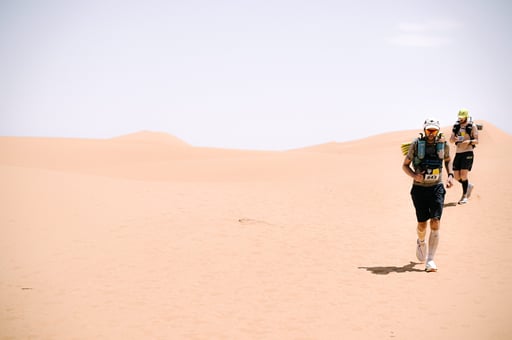
A quest for venturing into the unknown on seemingly risky adventures has, for me, always been underwritten by prodigious research, planning and preparation, fueled by a relentless determination to experience something few have, and topped off with a healthy dose of grit, knowing that the journey is the goal, not the destination. Looking back, when my wife and I left to overland in an old 1979 Land Rover from South Africa to Uganda, my friends had asked me “how many guns are you taking with you?” - if only they knew.
The more I researched the MDS and understood about this storied event, the more I appreciated what a privilege it was going to be to participate; but I also began to appreciate how the reach of the MDS brand and the spectacle of the human undertaking would serve as a great platform to raise awareness, and an opportunity to give something back to a good cause in Africa.
Some selfless colleagues of mine started a very special program called BIKES4ERP as part of our not-for-profit program Elephants, Rhinos, and People (ERP). BIKES4ERP has raised funds for hundreds of bicycles for dozens of rural children in Southern Africa. These colleagues and their families volunteer their spare time not only to deliver the bicycles to the children in the rural communities, but also spend time training young adults as bike mechanics to ensure that the bicycles' utility and value is maintained.
Spurred on by the possibility of being able to give back, about six weeks before the MDS event I set up a fundraising campaign called Run4Bikes with the help of our ERP foundation in the hope of at least trying to raise some awareness and hopefully some funds. The campaign’s modest goal was to raise enough money to fund 10 bicycles for BIKES4ERP. Realizing there wasn’t much time to do proper fundraising, I set about sharing this with friends and family, and was supported by my colleagues at EPI-USE who posted this onto LinkedIn with an overwhelmingly warm reception.
After 12 months of planning and preparation of some 1,200 miles of running, five pairs of running shoes, two weeks of sauna training, and countless tweaking of food and gear, I found myself en-route from California to Morocco via Paris. It wasn’t until I arrived for my connection in Casablanca that I started to see fellow MDS tribesmen, easily identified by our bright Hoka running shoes, Raidlight expedition bags, and nervous energy.

I spent a few days acclimatizing in a small village oasis north of Errachidia and had a great experience meeting Spanish motocross adventurers, and French families casually exploring Morocco in their tiny sedans; and made acquaintances with three young Swiss men who were special forces veterans, also preparing to tackle the MDS in a few days. This cross-section of nationalities and personalities was a taste of what was to come at the MDS.
A Friday marked the official date all participants had to muster at Errachidia airport to check-in for the MDS. The organizers are French, and all event communications were led in French, followed by English translations. We were loaded onto buses and expeditiously shuttled 90 minutes away to a remote location marked with 150 black Berber tents set up neatly in a crescent. Disembarking the bus, we were offered bottles of water as the desert heat introduced itself.
On check-in, we were allocated to one of the numbered black Berber tents – essentially a piece of black hessian, held up by poles in the middle, sitting on a weathered carpet, with open sides. Eight people were assigned per tent, and the ‘sardines in a tin can’ metaphor came to mind as we lived and slept side-by-side with seven other people over the next nine days.
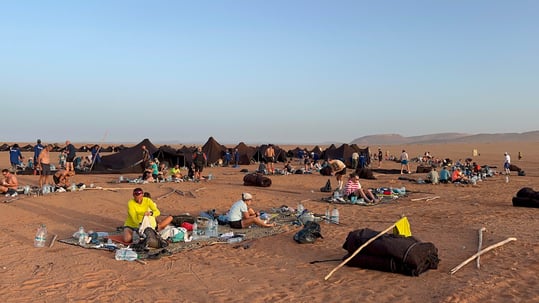
The camp was very well organized, and it was clear it was not the first time the organizers had done this. We were told that there were roughly 1,100 participants, complemented by 700 staff, of which 100 were doctors; armed with 150 vehicles and three helicopters. A tent mate remarked that a 1:10 ratio of doctor to participant seemed excessive, but as the event progressed we discovered the logic behind this.
Saturday reminded me of my short time doing national service, spending lots of time in the hot sun standing in long lines queuing up for mandatory medical and kit checks. In order to be officially allowed to participate, we had to provide a printed ECG and health report signed by a doctor; our kit bag had to weigh at least 6.5kg (14.3lbs); and we had to present our mandatory gear comprised of items such as a sleeping bag, hat, sunscreen, compass, signaling mirror, and a snake antivenom kit.
When we were finally through all the checks, we were allocated a Spot GPS device that was secured to our kit bag. We were also given a big bag of salt tablets with instructions on how many to take to prevent heat sickness. With the footrace starting the Sunday morning, we then had to hand in our luggage, and were left with only our kit bags. We were allocated more water that was to last throughout the night and through the first checkpoint of the race the following day.
My tent was representative of the event’s diversity; I had been allocated to a USA tent based on my passport, and my tent mates consisted of an English expat from Surrey, an English couple from Newcastle, a Mexican expat living in Miami, and three genuine Americans: a couple, and a young social media star from Arizona who was there to do the MDS in preparation for the Badwater 135 event later that year in Death Valley. This was my ‘new normal’ for the next week.
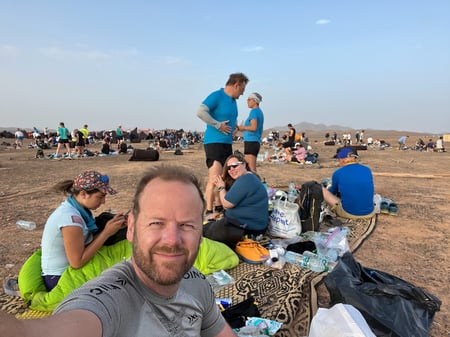
I made a rookie mistake that day by not drinking enough water, and went to bed feeling awful and shivering in my tent. On the Sunday morning, my fancy Garmin watch alerted me that my body battery was 18% and that I should ‘rest up and recover’ that day, not exactly the vote of confidence I had been looking for as I toed the line with a thousand-odd other people to begin the race!
The starting line was eclectic, with loud music piped out of large speakers mounted at the starting line, and also on the battered Land Rover Defender that served as the race director’s podium. Each day, he would climb up and stand on the roof rack with his microphone, dance to the music, and then rattle out that day’s course logistics in French, with the English translator trying to keep up in between breaths, and a helicopter flying around videographing the spectacle.

After a 20 minute build-up, ACDC’s Highway to Hell would give way to the 3,2,1 countdown, and we would head off into the shimmer, a medley of sahara-style hats with neck covers, lots of lycra pants, plenty of poles bouncing around, smiling outwardly while deeply focused internally.
The course was beautiful, the few people we did encounter were friendly. The course organizers were artful in their approach of selecting compass bearings that took you in straight lines for many kilometers at a time across a salt pan, across a dry river bed, straight up over a jebel (mountain), and throwing in some sand dunes for dessert. Words can’t describe the majesty of the desert, having vistas so deep that you can see the curvature of the earth, and making distance sometimes impossible to judge accurately.
The Sahara desert did not disappoint. It is one thing to be fit enough to run 50 or 100 km, do heat training in a dry sauna, train to run with a heavy backpack, etc. What I learned is that it is something different entirely doing this all together in the extreme dry heat. After about 12 pm, the heat would reflect back from the surface, offering no escape. It was so dry and hot that you wouldn’t notice you were sweating, and many a competitor started to succumb to a combination of poor water and salt replacement, resulting in heat sickness. I witnessed firsthand a few people getting evacuated by helicopter due to this malaise, and I better appreciated the complement of staff organized to ensure our well-being each day throughout the event.
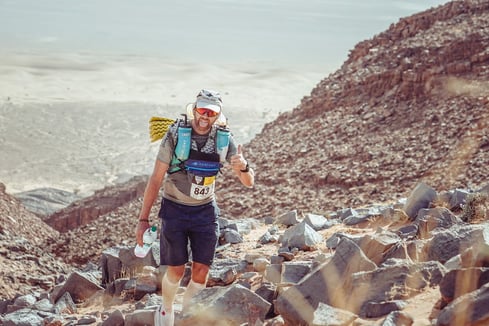
My experience in the desert was so extreme it transcended the bravado endurance event I thought it was into a journey of intense personal introspection and discovery. Someone joked that you just have to become comfortable with being uncomfortable, and that sums it up in a very understated fashion. Quoting Simon Sinek, you had to ‘find your why’; most did, a third didn’t. In that one short week, I made lifelong friends and broadened my horizons more than I could ever have imagined.
Rory Coleman, a respected athlete and coach for many who attempt the MDS sums it up nicely in his blog: “I personally love the deconstruction-reconstruction aspect that everyone who takes part experiences. And if you have taken part, you’ll know exactly what I mean, as trying to describe it is simply impossible.” Ian Corless, an endurance athlete and professional photographer, summarized this year's MDS event beautifully with spectacular visuals.
After much soul-searching, I reached the finish line of the last stage held in the stunning Merzouga Dunes, the location where Lawrence of Arabia was filmed. The 700 of us who were left were hustled onto waiting buses, and had to endure a seven-hour winding bus trip over mountains to Ourzazatte, called the Hollywood of Morocco. We got to wash off our nine days of cumulative grime, and I left about a pound of sand in the shower.
After a meal and the obligatory Casablanca beer, we received our finishers T-shirts the next day, and hurriedly stocked up on gifts for our loved ones before starting the long trek home. Air Morocco and United shuttled me with first-world expediency back to the USA, complete with the long-distance stare that Sahara veterans secretly share.

In between flights, I spent time reading all the emails and WhatsApp words of encouragement that people had sent. I was eager to revisit my modest fundraising campaign that was timed to end as I finished the MDS, and I am thrilled to share that we raised a total of $5,300 USD. And that, with every dollar going directly to bicycles, is enough for 20 bicycles for some very special people!
On a personal note, it felt uncomfortable initially putting my story out there and asking people for donations, but in hindsight, this is one of my most rewarding human experiences. I would encourage you to find your hill to climb, ocean to row across, and special people to help. While you are at it, please consider sharing the incredible story of BIKES4ERP.
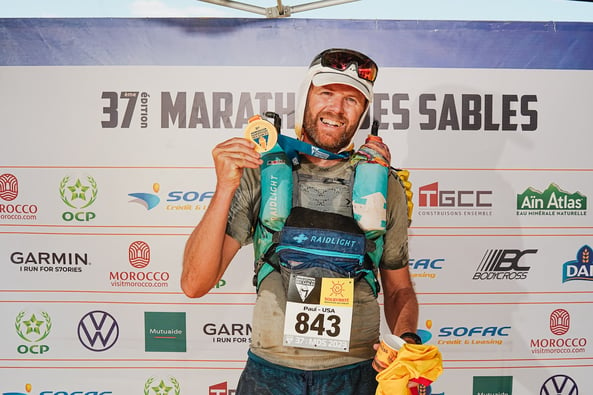
Paul Snyman
Paul is a passionate technologist and client advocate. He has over 25 years of diverse enterprise technology experience and is based in Silicon Valley, California. He is currently serving EPI-USE Labs responsible for product and innovation.